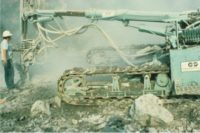 The public comment period on OSHA’s proposal to reduce worker exposure to silica dust ended this week, leaving the agency with more than 2,700 responses to process.
The public comment period on OSHA’s proposal to reduce worker exposure to silica dust ended this week, leaving the agency with more than 2,700 responses to process.
The rule would decrease the permissible exposure limit for crystalline silica dust – a substance that causes cancer, silicosis, chronic obstructive pulmonary disease and kidney disease in those who are exposed to it. The agency predicts that the new rule will save 700 lives and prevent 1600 new cases of silicosis each year
Two separate standards
The proposal includes two separate standards—one for general industry and maritime employment, and one for construction. The amount of silica exposure allowed for general industry and maritime workers would be cut in half. The change in exposure limits for the construction industry would be even more drastic: an 80 percent decrease.
Predictably, worker safety advocates support the rule, while business groups warn that it would force them to eliminate jobs and would ultimately harm the economy.
Both the American Industrial Hygiene Association (AIHA) and the American Society of Safety Engineers (ASSE) are backing the rule – with some recommendations for changes. Read the complete AIHA comments here and the ASSE comments here.
In its comments, advocacy group Public Citizen called the current silica rules "badly outdated."
"We believe it is crucial that OSHA adopt the most protective standard with respect to silica exposure," wrote Keith Wrightson, worker safety and health advocate at Public Citizen.
Not tough enough?
However, a change from the original rule met with criticism by another advocacy group, the Center for Progressive Reform. A requirement that employers pay for medical surveillance for workers exposed to silica dust was watered down when OSHA raised the level that would trigger the exam – and the expense for companies.
"Obviously, both changes make the proposed rule less protective of workers — and less costly for employers," CPA scholar Tom McGarity and CPR analyst Matthew Shudtz wrote in a blog after they submitted their comments to the agency.
On the other hand…
The National Roofing Contractors Association (NRCA) says the rule may actually make roofers’ jobs more dangerous by requiring employers to put engineering controls in the limited space of a rooftop, thereby taking up room that would otherwise be used for fall protection equipment.
“The paramount concern for worker safety in the roofing industry as always will be the prevention of falls, which continue to be the leading occupational cause of death for roofing workers,” said NRCA executive vice president William Good. Good called the proposal “dangerously deficient with respect to the roofing industry’s workforce and ignores the unique nature of roofing work.”
The U.S. Chamber of Commerce said the rule would place U.S. companies at a competitive disadvantage and is unnecessary, since the number of silica-related deaths has declined significantly in the past four decades.
OSHA plans to hold a series of public hearings on the proposed rule beginning March 18.
